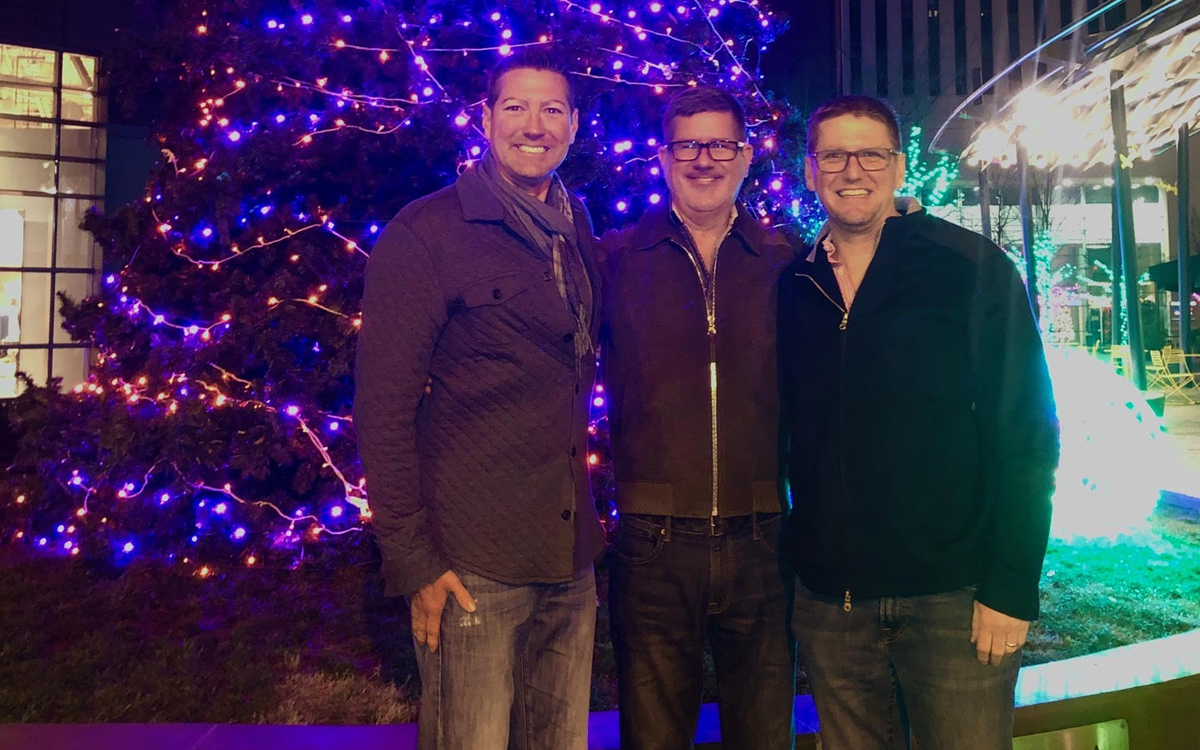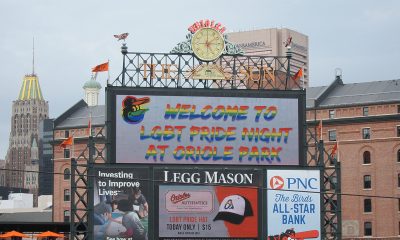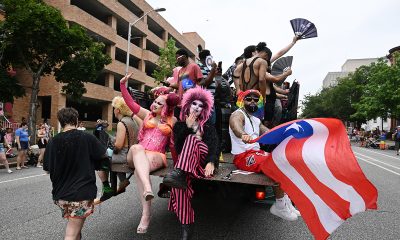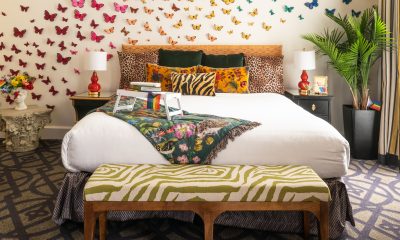Opinions
I survived overwhelming grief thanks to unexpected support systems
A lifeline I didn’t know I had — or needed

When tragedy strikes, you never know what will happen next. What’s the next punch in the gut that will knock you unconscious? That is what happened to me on March 20, 2021, when my beautiful, healthy, loving brother Tom died suddenly of a heart attack. A man who was 53 years old, ran five miles a day, and ate salads, tuna, and grilled chicken. And here I was, his younger brother, who sometimes eats poorly and rarely exercises, left to pick up the pieces once again.
The news came as a shock. My husband and I were relaxing, reading the paper and having a mimosa. Then, my brother’s mother-in-law called. As she relayed to me what had happened, I blacked out, unable to comprehend what she was saying. In fact, I did not even know who she was. I handed the phone to my husband, confused and convinced that what was happening was not actually happening. But it was happening. My brother was dead, and my precious 15-year-old niece was alone with him when it occurred.
I collapsed on the floor and was inconsolable, and I remained in that state for hours. Even our two cats were concerned, circling me nonstop, as I loudly wailed and screamed, noises they had never heard in the 11 years since we adopted them from the shelter. Finally, my husband Paul told me that I had to call my parents to tell them what had happened. Somehow, I mustered the strength to do so, recalling the similar moment in 1997 when my parents called me to inform me that my oldest brother David had died by suicide. I called them, but I don’t remember much of what I said. All I remember was my mom saying, “Not Tom!” Next, I called my mom’s sister and informed her of the news. More shock, grief, anguish, and confusion. Worried about my parents being alone, I left messages with their friends, Jack and Nina, and asked if they could go over and be with them until I could get there.
My husband, Paul, and I struggled that day to simply figure out how and when to fly to South Carolina to be with my family. I was completely useless, unable to do anything to help with arrangements. Paul put aside his grief for the loss of his brother-in-law and friend to take care of me, like he’s always done. And ever since, he has continued to do so—through all of my anxiety attacks, grief, anger, and inability to attend social functions. He has been my rock, and my love for him has never been greater.
What happened in the days after I got to South Carolina remains a blur — flowers, gifts, kind calls, me having to write my brother’s obituary and help with arrangements, including picking up the death certificate — on my birthday no less. What also happened was silence. Silence from friends and family members who I assumed would be there in my greatest moment of need but were surprisingly absent. Finally, my good friend Kevin said it best: “Don’t focus on those who have disappointed you; focus on those who have surprised you by being there.”
Great advice? Yes. Easy to follow? Not exactly.
However, I followed Kevin’s advice. I was confident that I could rely on my closest group of friends — the “Balt 8” (named for eight of us who became great friends while living in Baltimore). Later that year, while attending my first party since Tom’s death, I had a horrific anxiety attack, and Kevin asked no questions and instead took me for a long walk in the cold and misty rain. My best friend, Joy, who I have known since college and is like a sister to me, was there day and night. My close friend Maureen sent me TV recommendations to help make me laugh.
While I knew that the Balt 8 would lift me up, what I remember the most during this time were the people who unexpectedly came to my rescue.
After Tom died, one of the first people who reached out to me was Renee, a friend from high school who I had not seen in person since our graduation in 1988. Suddenly this long-lost high school classmate became a rock who I would rely on for months to come and who sent care baskets filled with goodies from her home state of Louisiana. I guess it shouldn’t surprise me — on Jan. 6, 2021, when I, along, with most Americans watched in horror as a mob besieged the U.S. Capitol, I was living not too far away. Too shaken by what I had witnessed, I called my supervisor at The Trevor Project to let them know that I would not be able to perform my volunteer shift that night. Anxiously, I waited for my husband to get home safely from work when I saw an incoming call via Facebook Messenger. It was Renee. She just wanted to make sure that my husband and I were safe.
Other friends came through via simple acts — my friends Tim and Regan in Seattle held a candlelit vigil for my brother whom they had never met, while my friend Steve sends me texts often just to see how I was doing.
While we live in Washington, D.C., we still keep our sailboat in Baltimore where we were lucky enough to land on the marina’s J-Dock and quickly made friends. Self-dubbed “The Island of Misfit Toys,” after the classic Christmas special, somehow, we were all brought together and became friends. During my grief period, everyone on the J-Dock brought something different to the table. Some brought tenderness and love; others brought levity with crude jokes that I was embarrassed to laugh at. Our boat neighbor Carrie asked me each morning how I was doing, and when I was having a tough day, she’d recommend we go to the pool, where we would relax, have a cocktail and laugh nonstop, usually at ourselves. When the bouquet of flowers for Tom’s funeral arrived from the J-Dock, it was obvious that Carrie, a fellow college football fan, had chosen it — the beautiful orange and purple flowers were a testament to my brother’s beloved favorite team, the Clemson Tigers. It was very typical of Carrie — she shows her love in a quiet, reserved way, but it’s still felt strongly.
While I appreciated everyone’s support at the marina, there are two friends that I relied on more than any — Jon and Jill.
After Tom’s death, I learned that my family has a history of heart disease. I went to my doctor and had every conceivable heart-related test, and thankfully, there was no evidence of heart disease. However, that didn’t completely eliminate my fears. The thoughts kept racing in my head: “Tom was the healthy one, so how can I be OK?” One day, I called Jon to ask him if he could stay on the phone with me, as I was having an anxiety attack. With his trademark humor, he quickly said, “You are not having a heart attack, drama queen.” But then he added, “I’ll be right there.” And he was, time and time again.
Later that summer, I had a similar anxiety attack, and I texted Jill. Luckily, she works from her boat, so she was home, and when I asked if she had a few minutes, instinctively, she knew something was up. Within seconds, I could feel my boat shift, signaling that someone was coming aboard, and there was Jill with her chihuahua, Little Dog, to help calm my nerves. “I don’t know what to do,” Jill admitted. I explained that I didn’t either. “Why don’t we go for a walk and get off our boats?” she suggested. I agreed to walk just around the marina, as I did not feel emotionally strong enough to leave the safety net of the docks. We discussed what anxiety feels like, but we also enjoyed our surroundings and Little Dog’s idiosyncrasies. And I laughed. Thank goodness, I laughed.
My brother’s death also resulted in a seismic shift in my relationship with his ex-wife, Chris. On the surface, Tom and Chris’s relationship may have seemed unconventional to many — over the course of 30-plus years, they dated, broke up, dated again, married and divorced, but through it all, they remained best friends. They hung out together all the time, ran together several times a week, and, most importantly, they raised their amazing and kind daughter, Jordan.
When my oldest brother David died by suicide in 1997, Tom was the one who found him. Even though they were not dating at the time, Chris was there for my family, and, most importantly, Tom. Tom was frustratingly closed off emotionally sometimes, and never more so than after David’s death. Chris was the one person who could get him to open up, so thankfully he clung to her.
While Chris and I at times had grown apart since the divorce, Tom’s death thrust us back together. We were no longer simply former in-laws and friends; we were partners in pain.
Will I survive this? Yes, because I have no other choice. How? I have no idea, but I have to hold onto hope that whenever I am struggling, there will be someone who will unexpectedly fill my heart with love.
Gregory J. Alexander is a freelance writer and editor who lives in Washington, D.C., with his husband, Paul, and two cats.
Opinions
USAID’s demise: America’s global betrayal of trust with LGBTQ people
Trump-Vance administration dismantled agency after taking office

The U.S. Agency for International Development — proudly my institutional home for several years of my international development career and an American institutional global fixture since November 1961 — is no more.
How will USAID’s closure impact LGBTQI+ people around the world, especially in poor, struggling countries (“the Global South”)? Time will tell, but “dire,” “appalling,” and “shameful” are appropriate adjectives, given the massive increase in HIV/AIDS deaths that follow the callous, abrupt, and unspeakably cruel cut-off of funding for USAID’s health and humanitarian programming in HIV/AIDS prevention, treatment, and care.
Regarding LGBTQI+ people and issues, USAID worked in a tough neighborhood. In Africa alone, more than 30 countries in which USAID had programming still criminalize same-sex relationships, often to the point of imposing the death penalty. These fiercely anti-LGBTQI+ countries share harsh anti-LGBTQI+ punishments with most countries in the Middle East and North Africa. Other countries where USAID formerly worked retain colonial-era sodomy laws.
Where did USAID fit into all this turbulence? The agency was not allowed to transgress local laws, so how could it support the human rights of local LGBTQI+ people? USAID did so by building close and trusting relationships with local LGBTQI+ civil society, and by “superpower advocacy” for the universal human rights of all people, including those of us in the queer community.
I served at USAID’s Africa Bureau under the Obama administration, becoming the only openly transgender political appointee in USAID’s history. In that role, I was privileged to have a platform that caught the astounded attention of both queer people and of anti-LGBTQI+ governments around the world. If the president of the United States can elevate a transgender woman to such a senior position within the U.S. government, that open declaration of acceptance, inclusion, worth, and recognition set a precedent that many in the LGBTQI+ community worldwide hoped their countries would emulate.
Serving as an openly queer person at USAID also afforded me the opportunity to meet with many fiercely anti-LGBTQI+ senior politicians and government officials from African countries who sought USAID funding. Uganda’s first woman speaker of the parliament, Rebecca Alitwala Kadaga and her whole delegation came to see me at USAID in Washington about such funding. I had some very frank (and USAID-approved) “talking points” to share with her and her team about President Obama’s strong and secular commitment to equal human rights for all people. My tense meeting with her was also an opportunity to educate her as to the nature of the transgender, nonbinary, and intersex community — we who are simply classified and discriminated against as “gay” people in Uganda and in most countries in the Global South. I also had the chance to represent USAID in the “inter-agency” LGBTQI+ human rights task team led by openly gay U.S. Ambassador David Pressman, whose effective leadership of that Obama-era initiative was inspirational.
Working closely with professional, capable, and caring USAID career employees such as Ajit Joshi and Anthony Cotton, and with the strong and open support of the USAID Deputy Administrator Don Steinberg, I helped to craft and promote USAID’s very first LGBTQI+ policy. Under President Obama, USAID also created the LGBT Global Development Partnership, a public-private partnership supporting LGBTQI+ civil society groups throughout the Global South. USAID funding also increased for programs promoting LGBTQI+ inclusion, anti-violence, and relevant human rights protections. This programming expanded further (albeit never adequately funded) during the Biden administration under the able leadership of USAID Senior LGBTQI+ Coordinator Jay Gilliam and his team.
So what did it all mean? Has USAID left a footprint for the global LGBTQI+ community? Will its absence matter?
In my view, that answer is an emphatic yes. International development and humanitarian response go to the heart of recognizing, respecting, and caring about universal human dignity. USAID converted those ethical commitments into tangible and meaningful action, again and again, and modelled for the world what it means to truly include all persons.
My time serving at USAID was a high point of my career, being surrounded by the best of American civil servants and foreign service officers. For me, “USAID Forever” remains my battle cry. Let’s start thinking of how we will rebuild it, beginning in three years.
Chloe Schwenke is a professor at Georgetown University’s McCourt School of Public Policy.
Opinions
Community comes together to repair WorldPride history exhibition
Vandals damaged pictures, timeline walls on June 22

Earlier this month, vandals shouting homophobic slurs damaged the 8-foot hero cubes and timeline walls of the Rainbow History Project’s (RHP) WorldPride exhibition “Pickets, Protests, and Parades: The History of Gay Pride in Washington.” The week’s incident was the fifth homophobic attack on the exhibition chronicling DC’s LGBTQ+ History, the vandalism damage was only made worse by the storms this past week.
In response, RHP posted a call online for volunteers and donations and over a dozen volunteers showed up on Saturday to repair the exhibition in its final stretch.
It took three hours, but the group assembled during a heat advisory to bend the fences back into place, fix the cubes and zip tie all the materials together to keep them safe. Some of those who came out to volunteer, Slatt said, were known RHP volunteers but most were total strangers who had attended an event here or there or just wanted to get involved for the first time, one was even in D.C. as an out-of-town guest and after seeing the Instagram call, decided to spend their day lifting some heavy fencing back into place.
When asked why they showed up, volunteer Abbey said: “especially during Pride month, it’s so important to come together as a community, not just to celebrate, but to support each other. To know that this historic exhibit is even able to exist right now under this administration is really amazing. The fact that we’re just able to help continue it in its last leg of being out here is really important.”
“Rainbow History Project does a lot of work for the community,” another volunteer Ellie said, “they show up in a lot of ways that I think we really need right now, so in terms of being asked to come out and do a couple hours of lifting, that is something that we can easily support and do.”
“We put out a call asking for support from the community, and so we didn’t know what we’d get,” Slatt continued, “but strangers have shown up. We were upset, we were crying. We were trying to come up with a battle plan and more and more people have shown up with open arms and empty hands to do this. It’s 95 degrees, we are melting in the heat. It’s just amazing the number of people who have come here.”
If anything, the anonymous exhibit designer said, the people who vandalized the exhibit made the community stronger and mobilized members passionate about preserving and sharing our histories. Their efforts backfired in a big way — bringing together people who had only attended one or two RHP events or had read about the organization online to actively contribute to the work.
It’s a meaningful representation of the history of D.C.’s LGBTQ+ community, one that often starts with a small group of people who come together to protest but soon mobilize their communities and enact monumental change in the nation’s capital.
“If Pride in D.C. started with 10 people picketing the White House,” Slatt remarked, “you just got 12 more to join the gay history movement.”
This was especially poignant, another volunteer Mattie said, on the week that the Supreme Court issued a decision allowing Tennessee to ban puberty blockers and hormone therapy for minors seeking gender affirming care. It was a devastating moment for the LGBTQ+ community who mobilized once more in front of the Supreme Court this past Friday.
“It’s been actually really important to see this community come together in the face of direct attack on our history in the wake of direct attacks on our rights,” Mattie said, “and we stand up to that. We come together, and we represent. That is so important to maintaining our strength and our community throughout trying times now and ahead.”
When asked about how community members can support RHP’s work and repair the damage long-term to the exhibit, Slatt urged people to donate to RHP, to volunteer as exhibit monitors, and to come visit the exhibit.
“We’ve been doing this for 25 years. This is our 25th anniversary, and if it weren’t for volunteers donating their time and their talents, if it weren’t for small dollar donors, we would never have gotten anything done,” Slatt said. “I’d say to anyone out there that we are on this plaza all through Independence weekend, we are here through the Smithsonian Folklife Festival, people can come on down.”
Slatt and other volunteers will be leading tours each evening at 7 p.m. at Freedom Plaza, and people can pre-order the exhibition catalog right now, which will be delivered in time for LGBTQ+ History Month in October.
Emma Cieslik is a D.C.-based museum worker and public historian.

Independence Day, commonly known as the Fourth of July, is a federal holiday commemorating the ratification of the Declaration of Independence by the Second Continental Congress on July 4, 1776, establishing the United States of America. The delegates of the Second Continental Congress declared the 13 colonies are no longer subject (and subordinate) to the monarch of Britain, King George III and were now united, free, and independent states. The Congress voted to approve independence by passing the Lee resolution on July 2, and adopted the Declaration of Independence two days later, on July 4.
Today we have a felon in the White House, who wants to be a king, and doesn’t know what the Declaration of Independence means. Each day we see more erosion of what our country has fought to stand for over the years. We began with a country run by white men, where slavery was accepted, and where women weren’t included in our constitution, or allowed to vote. We have come far, and next year will celebrate 250 years. Slowly, but surely, we have moved forward. That is until Nov. 5, 2024, when the nation elected the felon who now sits in the Oval Office.
There are some who say they didn’t know what he would do when they voted for him. They are the ones who were either fooled, believing his lies, or just weren’t smart enough to read the blueprint which laid out what he would do, Project 2025. It is there for everyone to see. There should be no surprise at what he is doing to the country, and the world. Last Friday his Supreme Court, and yes, it is his, the three people he had confirmed in his first term, gave him permission to be the king he wants to be. The kind of king our Declaration of Independence said we were renouncing. A man who with the stroke of a pen can ruin thousands of lives, and change the course of America’s future. A man who has set back our country by decades, in just a few months.
So, I understand why many are suggesting there is nothing to celebrate this Fourth of July. How do we have parties, and fireworks, celebrating the 249th year of our independence when so many are being sidelined and harmed by the felon and his MAGA sycophants in the Congress, and on the Supreme Court. Yes, there are those celebrating all he is doing. Those who want to pretend transgender people don’t exist, and put their lives in danger; those who think it’s alright to take away a women’s right to control her body, and her healthcare; those who think parents should be able to interfere on a daily basis with their children’s schooling and wipe out the existence of gay people for them. Those who pretend there was a mandate in the last election, when it was only won by about 1 percent. Those who think disparaging veterans, firing them, and taking away their healthcare, is ok. Those in the LGBTQ community like Log Cabin Republicans, who think supporting a racist, sexist, homophobe is the right thing to do.
So, what do we, as decent caring people, do this Fourth of July. What do we say to those who are being harmed as we celebrate. What do we say to those trans people, those women, those immigrants who came here to escape their own dictators, and are now finding they have come to a country with its own would-be dictator. I say to them, please don’t give up on America. Don’t give up on the possibility decent loving people in our country will finally wake up and say, “enough.” That the majority of Americans will remember we fought a revolution to escape a king, and we fought a civil war to end slavery. That we moved forward and gave women the right to vote, and gave the LGBTQ community the right to marry. Don’t give up on the people that did all that, and think they won’t rise up again, and tell the felon, racist, homophobe, misogynist, found liable for sexual assault, now in the White House, and his sycophants in congress, and his cult, that we will take back our country in the 2026 midterm elections. That we will vote in large numbers, and demand our freedom from the tyranny that he is foisting on our country.
So yes, I will celebrate this Fourth of July not for what is happening in our country today, but rather for what our country actually stands for. Not for birthday parades, and abandonment of the heroes in Ukraine in support of dictators like Putin. But for the belief the decent people in our country will rise up and vote. That is what I will celebrate and pray for this Fourth of July. That is what I think the fireworks will mean this July Fourth. I refuse to accept defeat the same way our revolutionary soldiers wouldn’t, and the way our troops in the civil war wouldn’t till the confederacy was defeated.
I will celebrate this Fourth of July because I refuse to accept we will not defeat those who would destroy our beautiful country, and what it really stands for.
Peter Rosenstein is a longtime LGBTQ rights and Democratic Party activist.




















